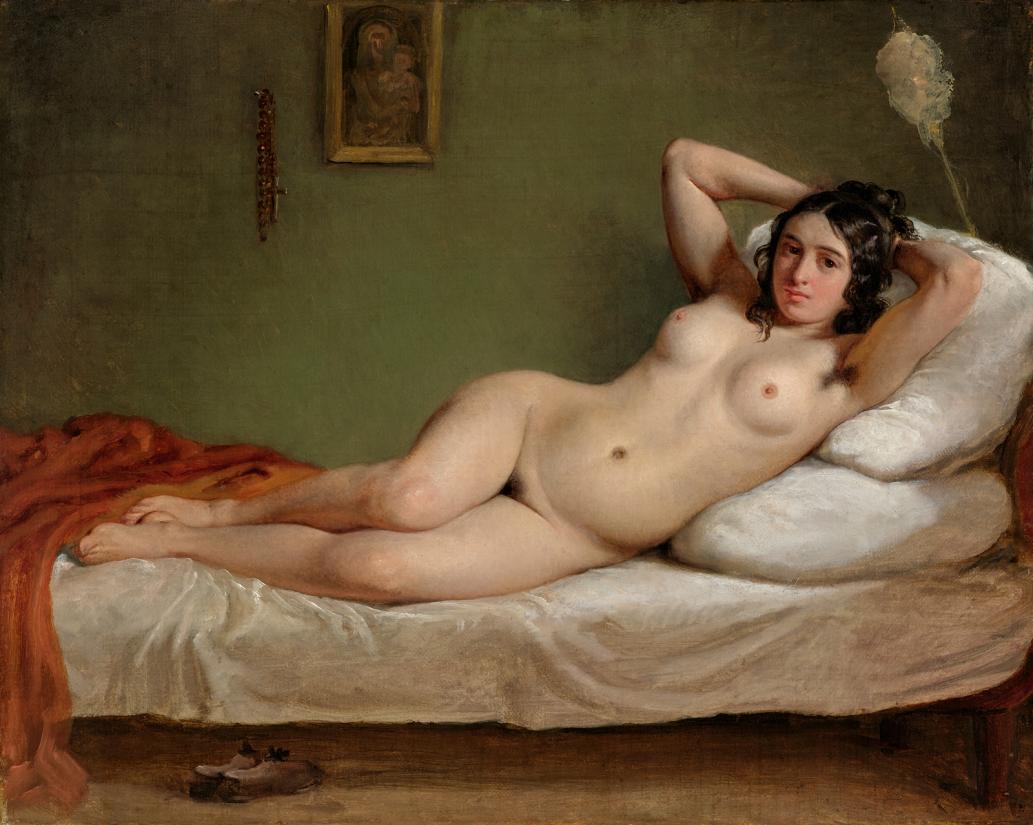Wilhelm Marstrand’s oil study of a female nude model is an intimate painting of modest size. However, Maria is not ‘just’ a nude. The intimacy of the artwork arises through her personal impact and presence. Her body is naked and deliberately twisted in a way that highlights her curves. And yet, through the rich detailing of the piece, Maria shines through. The woman’s gaze will challenge the beholder in unanticipated ways, if the beholder allows it.
Wilhelm Marstrand’s Maria, which has long been held in a private German collection, has now become part of the Nivaagaard Collection with support from the New Carlsberg Foundation.
The model’s personal presence and impact
Marstrand painted Maria a few months after his arrival in Rome in 1837. The main topic of the painting is the young woman’s naked body, slightly contorted, in an unmade bed. An orange bedspread lies casually tossed at her feet, and a pair of small slippers are neatly placed on the floor next to the bed.
On the wall in the background are a rosary and a picture of the Madonna and child in a gold frame, while protrudes above the woman’s head. These props underscore the calm everyday realism of the scene. At the same time, they have a vibrant artistic appearance, providing a dream-like frame around Maria’s almost hyper-realistic body in the pale daylight.
Maria has raised her arms and folded them behind her head while pushing her hip upwards in an equally defenceless and confrontational pose. From a modern-day perspective, Maria may be seen as a person leaning into the ambiguity of gender roles: she is acting the part of the active nude model, while her gaze questions and exposes this position.
Maria’s kindred spirits
From an art-historical perspective, Maria sparks associations to Manet’s Olympia, which was painted almost 30 years after Marstrand’s picture. Moreover, Maria strikes a similar pose to the Spanish painter Francisco Goya’s The Naked Maja from 1800, which was confiscated in 1808 during the Spanish Inquisition and stored out of sight. Thus, the source of the kinship between Goya and Marstrand is unknown, their only connection the personal impact of the two women.
Marstrand and Nivaagaard
The Nivaagaard Collection owns 41 paintings by Marstrand, who was a close friend of the museum’s founder, Johannes Hage, and his family. As the most extensively represented artist in the collection, Marstrand is also the topic of a research-based publication and exhibition. Most of the works by Marstrand in the collection are genre scenes, small studies and sketches from Italy or portraits of the Hage family.
Both Maria and Lying Model from 1833, both nudes and the latter’s purchase also supported by the New Carlsberg Foundation supplement Nivaagaard’s figure paintings based on anatomical knowledge.
About Wilhelm Marstrand
Wilhelm Marstrand (1810–1873) graduated from the Royal Danish Academy of Fine Arts in 1833 under C. W. Eckersberg and is considered one of the most significant visual artists of the Danish Golden Age.
Marstrand’s artistic practice revolved mainly around two settings: Denmark and Italy. While Marstrand’s early works reflect his time in Copenhagen, his later works show the influence from his sojourns in Italy after his graduation.
During this latter period, his international outlook and sources of inspiration such as Rembrandt, Titian and Veronise is evident in his fascination with local Italian scenes. Thus, Marstrand never dealt with overtly national themes but remained a master of synergy who transplanted universes from both Denmark and abroad in his chosen topics and genres.



